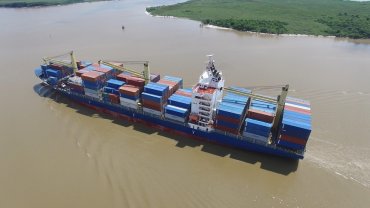CHICAGO – The U.S. Environmental Protection Agencys Vessel General Permit created a global standard that has drastically affected the marine lubes industry by requiring environmentally acceptable lubricants, an industry insider told a conference here last month.
The VGPs introduction in 2013 moved the market within months and is the most significant regulation concerning EALs in the world, said Pete Vickers, chairman and managing director of Vickers Oils, at the ICIS and European Lubricating Grease Institutes North American Industrial Lubricants Congress on Sept. 19. It suddenly created demand for the specialty oils, and has encouraged advances in technology and equipment design. More changes may be on the horizon, as an updated 2018 Vessel Generation Permit is expected before the end of this year.

Photo: Computer Depot/Shutterstock
A cargo ship in southern Texas. An EPA regulation requiring environmentally acceptable lubricants has caused drastic changes in the marine lubes industry, an industry insider says.
Although it is a domestic U.S. regulation, its become de facto a global regulation because of the amount of [shipping] traffic that comes to and from the United States, he pointed out. International ship owners wanted flexibility with their fleets, so they just decided to get on and convert all their vessels. Whether they were trading to the United States at that time or not, they wanted the flexibility to do so.
The policy regulates discharges caused by normal operations of commercial vessels in U.S. territorial waters and the Great Lakes. It includes specific requirements for products used to lubricate stern tubes and other equipment that may be immersed in or otherwise in direct contact with seawater, referred to as oil-to-water or oil-to-sea interfaces. Commercial vessels longer than 79 feet must use EALs in all oil-to-sea interfaces, such as controllable pitch propellers, azimuth thrusters and paddle wheel propulsion systems. EPA defined EALs as “biodegradable” and “minimally-toxic,” and as “not bio-accumulative.”
EPA issued a separate Small Vessel General Permit in September 2014 for control of incidental discharges for vessels less than 79 feet in length. As a result of Congressional legislation, these smaller vessels werent required to obtain coverage under that permit until Jan. 19, 2018, except for any ballast water discharges.
Vickers said his United Kingdom-based company began to develop the first marine specific EALs in 1993 when a Swedish customer suggested making a biodegradable version of one of its existing stern tube oils. The British company launched its first commercially available EAL product in 2002.
Wed been able to demonstrate that with these products, this technology was fit for purpose. The VGP could mandate proven technology rather than force development of something that had not yet been achieved and tested. And of course product development continued on since then and does so now, he said.
Vickers credited the regulation with having very practically defined eco-criteria and providing multiple routes for EAL makers to achieve its requirements by accepting various labeling schemes. He noted it was crucial that the VGP involved original equipment manufacturers in the performance approvals system. I think that was a stroke of genius by the regulators, EPA, to exclude themselves from that aspect, said.
Compared to other regulations impacting commercial vessels, adjusting to the policy was relatively low-cost and easy to do. Certainly our experience was most ship owners got on and did it in the first couple of years of the regulation being in force. They just converted their whole fleets. I would say nowadays the great majority of the deep-sea fleets are using EALs, Vickers told attendees.
He noted that the changeover was made easier on vessel owners because it was implemented slowly over time. It didnt say you had to do it from day one, he explained. As your vessel comes into dry dock for its routine, normally five-year cycle for docking inspection and maintenance, thats the time to change over to EALs.
According to Vickers, the changeover and accompanying surge in EAL demand took place mainly from 2013 to 2015.
Marine lubricant marketing strategies also faced changes thanks to the VGP regulations. What had been a voluntary initiative suddenly became a mandated market, he said, referring to EALs. We spent 10 years wandering around the world trying to persuade people to pay four times as much for something they didnt have to use, he said. In 2013, they just started ringing us up – we didnt have to go to them, it moved that fast.
The EAL market created by the U.S. regulations also benefited suppliers of the formulation components. A lot of our suppliers started paying much more attention to this because the market has been mandated and created, so its a bigger market for them, Vickers said. Therefore, they started to develop new base fluids and additives especially for these sorts of applications. Thats enabled the performance to improve and all the costs of EALs to come down.
VGP regulation has also encouraged the development of technology-based alternative equipment that works better in conjunction with EALs or, sometimes, as an alternative to such lubricants.
Seal-makers came up with seals that had better compatibility to EALs, he said. Some have developed seals which no longer count as an oil-to-sea interface. There are also electric hydraulic systems being proposed and water-lubricated systems. So over the long term, the VGP has encouraged not merely use of EALs, but technology as an alternative to EALs.